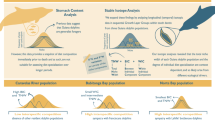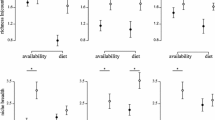Summary
Habitat and food resource partitioning ecologically isolate six species of Pacific Northwest dorid nudibranchs. Food resources along a gradient of sponge skeletal structure are partitioned between two exploitive guilds. The guilds are characterized by mutually exclusive predatory and digestive adaptations which allow efficient processing of sponges with poorly- or well-organized skeletons. Habitats along a depth gradient are partitioned within guilds. For a dorid species, feeding rates, extraction efficiencies and food quality are virtually identical for sponges with the appropriate extreme (either poorly- or well-organized) and intermediate skeletal organizations, but growth and reproductive rates supported by the former prey type are twice those supported by the latter prey type. Prey types with the appropriate extreme skeletal organization are thus optimal food and specialization to that food is expected. When two divergent specialist species co-occur, food resource partitioning is demonstrable but arises from self-stabilizing specializations to maximize net energy accumulation and not from competitive interactions. Habitat partitioning is viewed as arising from prey distributions and dorid physiological tolerances. This system represents an example of morphological and behavioral specializations giving rise to resource partitioning as opposed to competition giving rise to resource partitioning and subsequent morphological and behavioral specializations.
Similar content being viewed by others
References
Abrams P (1980) Some comments on measuring niche overlap. Ecology 61:44–49
Bakus G (1966) Marine poeciloscleridan sponges of the San Juan Archipelago, Washington. J Zool Lond 149:415–531
Bergquist PR, Hartman WD (1969) Free amino acid patterns and the classification of the Demospongiae. Marine Biol 3 (3):247–268
Bergquist PR, Morton JE, Tizard CA (1971) Some demospongiae from the Solomon Islands with descriptive notes on the major sponge habitats. Micronesica 7:99–121
Bergquist PR, Sinclair ME (1968) The morphology and behavior of larvae of some intertidal sponges. N Z Jl Mar Freshwat Res 2:426–437
Bergquist PR, Sinclair ME, Hogg JJ (1970) Adaptations to intertidal existence: reproductive cycles and larval behavior of Demospongiae. Symp Zool Soc Lond 25:247–271
Birch LC (1957) The meaning of competition. Am Nat 91:5–18
Bloom SA (1974) Resource partitioning among the doridacean nudibranch molluscs of the San Juan Archipelago, Washington; a guild hypothesis. PH D Dissertation, University of Washington, pp 157
Bloom SA (1976) Morphological correlations between dorid nudibranch predators and sponge prey. Veliger 18:289–301
Bloom SA, Simon JL, Hunter VD (1972) Animal-sediment relations and community analysis of a Florida estuary. Marine Biology 13 (1):43–56
Boesch DF (1977) Application of numerical classification in ecological investigations of water pollution. Special Scientific Report no. 77, VIMS (EPA-600/3-77033) pp 115
Carefoot TH (1967) Growth and nutrition of three species of opisthobranch molluscs. J Comp Biochem Physiol 21:627–652
Caswell H (1978) Predator-mediated coexistence: a nonequilibrum model. Am Nat 112:127–154
Chia FS, Skeel M (1973) The effects of food consumption on growth, fecundity and mortality in a sacoglossan opisthobranch, Olea hansineenis. Veliger 16:153–158
Cody ML (1968) On the methods of resource division in grassland bird communities. Am Nat 102:107–147
Colwell RK, Futuyma DJ (1971) On the measurement of niche breadth and overlap. Ecology 52 (4):567–576
Connell JH (1961) The influence of interspecific competition and other factors on the distribution of the barnacle Chthamalus stellatus. Ecology 42:710–723
Connell JH (1970a) A predator-prey system in the marine intertidal region: I. Balanus glandula and several predatory species of Thais. Ecol Monogr 40:49–78
Connell JH (1970b) On the role of natural enemies in preventing competitive exclusion in some marine animals and in rain forest trees. Proc Adv Study Inst Dynamics Numbers Pop (Oosterbeek), 298–312
Culver DC (1976) The evolution of aquatic cave communities. Am Nat 110:945–957
Da Cunha AB, Dobzhansky T, Sokoloff A (1951) On food preferences of sympatric species of Drosophila. Evolution 5:97–101
Da Cunha AB, El-Tabey AM, Shehata de Olivera W (1957) A study of the diet and nutritional preferences of tropical species of Drosophila. Ecology 38:98–106
Darlington PJ Jr (1972) Competition, competitive repulsion, and coexistence. Proc Nat Acad Sci 69:3151–3155
Dayton PK (1973) Two cases of resource partitioning in an intertidal community: making the right prediction for the wrong reason. Amer Nat 107:662–670
de Jong G (1976) A model of competition for food. I. Frequencydependent viabilities. Amer Nat 110:1013–1027
de Laubenfels MW (1932) The marine and fresh water sponges of California. Proc US Nat Museum 81: (4), 1–140
de Laubenfels MW (1961) Porifera of Friday Harbor and vicinity. Pac Sci 15: (2):192–202
Dunham AE, Tinkle DW, Gibbons JW (1978) Body size in island lizards: a cautionary tale. Ecology 59: (6):1230–1238
Eadie J (1969) Sheep production and pastoral resources. In: Animal Populations in Relation to their Food Resources. A. Watson, Ed Brit Ecol Symp # 10. Blackwell Scientific Publ, Oxford, 7–24
Edington JM, Edington MA (1972) Spatial patterns and habitat partitioning in the breeding birds of an upland wood. J An Ecol 42:331–358
Emlen JM (1968) Optimal choice in animals. Am Nat 102:385–389
Emery AR (1973) Comparative ecology and functional osteology of fourteen species of damselfish (Pisces: Pomacentridae) at Alligator Reef, Florida Keys. Bull Mar Sci 23 (3):649–770
Forrest JE (1953) On the feeding habits and the morphology and mode of functioning of the alimentary canal in some littoral dorid nudibranchiate molluscs. Proc Linn Soc Lond 64:225–235
Fournier A (1969) Anatomie histologie et histochimie du tube digestif de Peltodoris atromaculata Bergh. Vie et Milieu 20:73–93
Franz DR (1975) Opisthobranch culture. In: Culture of Marine Invertebrate Animals, Plenum Press, New York, pp 245–256
Fraser DF (1976) Coexistence of salamanders in the genus Plethodon: A variation of the Santa Rosalia theme. Ecology 57:238–251
Gatz AJ (1979) Community organization in fishes as indicated by morphological features. Ecology 60:711–718
Hadfield MG (1963) The biology of nudibranch larvae. Oikos 14:85–95
Hadfield MG (1977) Chemical interactions in larval settling of a marine gastropod. In: Marine Natural Products Chemistry, Plenum Press, New York, pp 201
Harris RP (1972) Horizontal and vertical distribution of interstitial harpacticoid copepods of a sandy beach. J Mar Biol Ass UK 62:375–387
Hartley PHT (1948) Food and feeding relationships in a community of freshwater fishes. J Anim Ecol 17:1–13
Heinrich B (1976) Resource partitioning among some cusocial insects: bumblebees. Ecology 57:874–889
Huey RB, Pianka ER (1977) Patterns of niche overlap among broadly sympatric versus narrowly sympatric Kalahari lizards (Scincidae: Mabuya). Ecology 58:119–128
Hyman LH (1940) The Invertebrates: Protozoa through Ctenophora, Vol 1: New York: McGraw-Hill, p 726
Jaeger RG (1971) Competititve exclusion as a factor influencing the distribution of two species of terrestrial salamanders. Ecology 52:632–637
Jones RS (1968) Ecological relationships in Hawaiian and Johnston Island Acanthuridae (surgeonfishes). Micronesica 4:309–361
Kandel P, Capo R (1979) The packaging of ova in the egg cases of Aplysia californica. Veliger 22:194–198
Leviten PR (1979) Resource partitioning by predatory gastropods of the genus Conus on subtidal Indo-Pacific coral reefs: the significance of prey size. Ecology 59:614–631
Light SF, Pitelka FA, Abbott DP, Wessner FM, Smith RI (1954) Intertidal Invertebrates of the Central California Coast. University of California Press. Berkeley, p 466
MacArthur RH (1958) Population ecology of some warblers of northeastern coniferous forests. Ecology 39:599–619
MacArthur RH (1972) Geographical Ecology. Harper and Row, New York, pp 269
MacArthur RH, Levins R (1964) Competition, habitat selection, and character displacement in a patchy environment. Proc Nat Acad Sci 51:1207–1210
MacArthur RH, Levins R (1967) The limiting similarity, convergence, and divergence of coexisting species. Am Nat 101:377–386
MacArthur RH, Pianka ER (1966) On optimal use of a patchy environment. Am Nat 100:603–609
May RM (1974) Stability and Complexity in Model Ecosystems. Princeton University Press, Princeton NJ, p 265
Menge BA (1972) Competition for food between two intertidal starfish species and its effect on body size and feeding. Ecology 53:633–644
Mitchell R (1969) A model accounting for sympatry in water mites. Am Nat 103:331–346
Miller RS (1967) Pattern and process in competition. In: Advancements in Ecological Research, 4:1–74, JB Cragg (ed), Academic Press, New York, NY
Millott N (1937) On the morphology of the alimentary canal, process of feeding, and physiology of digestion of the nudibranch mollusc Jorunna tomenstosa (Cuvier). Phil Trans Roy Soc Lond Series B 228:173–217
Nicholson AJ (1955) An outline of the dynamics of animal populations. Aust Jour Zool 2:9–65
Nybakken JJ, Eastman J (1977) Food preference, food availability and resource partitioning in Triopha maculata and Triopha carpenteri (Opisthobranchia: Nudibranchia). Veliger 19 (3):279–289
Paige JA (1979) The ecology, larval biology, substrate selection and post-larval development of Bursatella leachii plei (Gastropoda: Opisthobranchia) Rang. Doctoral Dissertation, University of Florida, pp 86
Paul AJ, Paul JM, Hood DW, Neve RA (1977) Observations on food preferences, daily ration requirements and growth of Haliotis kamschatkana Jones in captivity. Velger 19:303–309
Pianka ER (1969) Sympatry of desert lizards (Ctenotus) in western Australia. Ecology 50:1012–1030
Pianka ER (1974) Niche overlap and diffuse competition. Proc Nat Acad Sci USA 71 (5):2141–2145
Rathcke BJ (1976) Competition and coexistence within a guild of herbivorous insects. Ecology 57:76–87
Reynoldson TB, Davies RW (1970) Food niche and coexistence in lake-dwelling triclads. J An Ecol 39:599–618
Root RB (1967) The niche exploitation pattern of the blue-gray gnatcatcher. Ecol Monogr 37:317–350
Rose BR (1976) Habitat and prey selection of Sceloporus accidentalis and Sceloporus graciosus. Ecology 57:531–541
Roughgarden J (1972) Evolution of niche width. Amer Nat 106:683–718
Roughgarden J (1974) Species packing and the competition function with illustrations from coral reef fish. Theor Popul Biol 5:161–186
Sale PF (1974) Overlap in resource use and interspecific competition. Oecologia (Berl) 17 (3):245–256
Sale PF (1977) Maintenance of high diversity in coral reef fish communities. Am Nat 111:337–359
Schoener TW (1968) The Anolis lizards of Bimini: resource partitioning in a complex fauna. Ecology 49:704–726
Schoener TW (1974) Resource partitioning in ecological communities. Science 185:27–39
Shonman D, Nybakken JW (1978) Food preferences, food availability and food resource partitioning in two sympatric species of cephalospidean opisthobranchs. Veliger 21 (1):120–126
Siegel S (1956) Nonparametric Statistics for the Behavioral Sciences. McGraw-Hill, New York, pp 312
Sokal RR, Rohlf FJ (1969) Biometry. WH Freeman and Company, San Francisco, pp 776
Thompson TE (1958) The natural history, embryology, larval biology and postlarval development of Adolaria proxima (Adler and Hancock) (Gastropoda: Opisthobranchia). Phil Trans Roy Soc Lond B 242:1–58
Vance RR (1973) On reproductive strategies in marine benthic invertebrates. Am Nat 107:329–352
Vandermeer JH (1972) Niche theory. Ann Rev Ecol Syst 2:107–132
Werner EE (1977) Species packing and niche complementarity in three sunfishes. Am Nat 111:553–578
Werner EE, Hall DJ (1977) Competition and habitat shift in two sunfishes (Centrarchidae). Ecology 58:869–876
Werner EE, Hall DJ (1979) Foraging efficiency and habitat switching in competing sunfishes. Ecology 60 (2):256–264
Whittaker RH (1967) Gradient analysis of vegetation. Biol Rev 42:207–264
Whittaker RH, Levin SA, Root RB (1973) Niche, habitat and ecotope. Am Nat 107:321–338
Author information
Authors and Affiliations
Rights and permissions
About this article
Cite this article
Bloom, S.A. Specialization and noncompetitive resource partitioning among sponge-eating dorid nudibranchs. Oecologia 49, 305–315 (1981). https://doi.org/10.1007/BF00347590
Received:
Issue Date:
DOI: https://doi.org/10.1007/BF00347590




